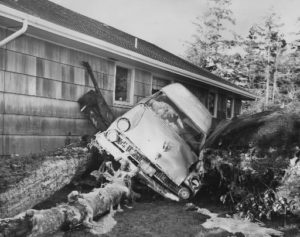You’d think this would be one of the first decisions you made when you decide to write a book, but it’s a little more convoluted than that.
I started out with the field guide which was based off of a tri-fold laminated memory-aid I developed for the fire, EMS and law enforcement work I was doing. Content creation was pretty simple. As I started looking at working with top notch publishers they were interested not just in content but customer base appeal. It makes you rethink the audience and topics, usually making more work, but producing a good product.

Selecting a Cascadia event for my novel, Thunderbird and Whale, was easy as it is something I have been interested in for some time.
Growing up on the Oregon coast, picking up pumice from off-shore underwater volcanoes and first hand experiencing the effects of the 1964 tsunami generated in Alaska’s big quake were images permanently implanted in my head.

When my professional career allowed me to be an emergency manager in a coastal county the challenges of Cascadia became very real. Superimposing a Cascadia generated tsunami at an order of 5-10 times higher than my personal memories of the 1964 event gives me a terrifying perspective of what this event will look like. I didn’t want to just do a disaster novel where all is lost but also include ideas I researched that I think have merit in the book to enhance opportunities for survival and recovery. Such as:
- Disaster supply vending machines
- Kabuki cabs with evacuation support duties
- Better building markings for safe areas
- Outdoor assembly areas and evacuation routes clearly marked
- Citizen training in catastrophic disaster response and recovery operations
- Enhanced building design
- Business disruption insurance as part of rental space agreement
- Land use restrictions based on hazard zones
- Public education on locally sourced, preserving and foraged food supplies
- MOUs with commercial fishing fleet with potable water-making capacity
- MOU with Japan for international assistance
- Better appreciation for Native American history of last Cascadia
- Emergency power generating capacity enhanced including conventional generators as well as solar power.
Many of the events described in the book are from my own life in Oregon. Commercial clamming, dory fishing (a lot of time around Tillamook Rock lighthouse), seeing many tourists gets in trouble in the ocean, hiking and camping (I’ll never tell where my Icebox canyon fishing spot is). Even the homes and locations are from real-life. For me it made it easier to keep track of where things were occurring and it should be a consideration as you write to be consitent.

The value of writing about this event which has become a part of me both personally and professionally has taken an interesting turn. Two of the innovative ideas I wrote about have surfaced to present themselves as opportunities by interested parties. Pretty exciting stuff and validation.
I hope these articles have given you some inspiration that now is the time for you to jump in the writing world. As always, reach out with comments, questions, thoughts or just to bounce an idea off me.




Hi, Jan.
I’ve followed your author’s story and after publishing my own book this last summer, it all sounded so familiar! All that formatting using KDP . . .! (I finally bought a book design program that made everything a lot easier.)
My books (there are 4 of them) are on the topic of emergency planning, too. And based on my own experiences with turning a group of unrelated and pretty much untrained neighbors into a neighborhood emergency response team!
Now I’m inspired to write a book of fiction based on some of those same experiences.
I’ll let you know how it goes!
Virginia
That is great Virginia, go for it.